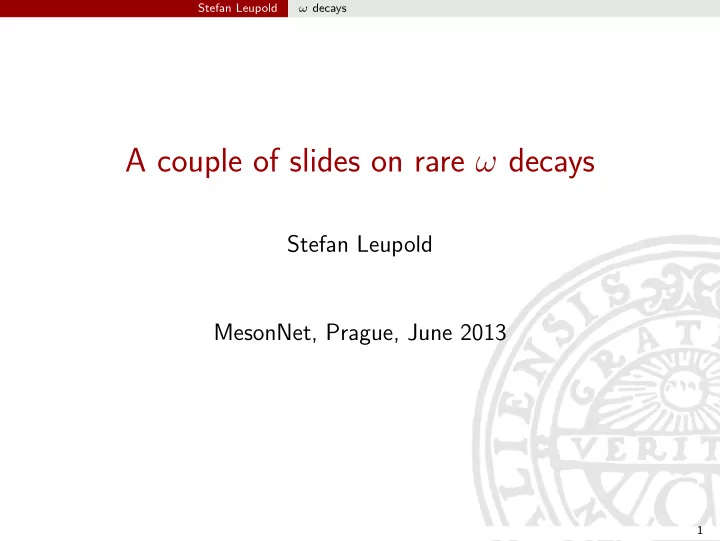

Stefan Leupold ω decays A couple of slides on rare ω decays Stefan Leupold MesonNet, Prague, June 2013 1
Stefan Leupold ω decays Motivation for g − 2 of muon and — not to forget — to learn more about the challenging part of QCD we are interested in 2- γ physics: hadron ( s ) ↔ γ ( ∗ ) γ ( ∗ ) if, for instance, m γ ∗ = m ω (or m φ , . . . ) → related to decays ω → γ ( ∗ ) + hadron(s) ֒ 1. for hadron = π 0 � related to transition form factor ω → π 0 + l + l − (with lepton l ) 2. for hadron = 2 π 0 � related to rare decay ω → π 0 π 0 γ 2
Stefan Leupold ω decays Transition form factor 100 NA60 ’09 [8] NA60 ’11 [9] Lepton-G [7] VMD Terschl¨ usen et al. [34] f 1 ( s ) = a Ω( s ) full dispersive figure from | F ωπ 0 ( s ) | 2 Schneider/Kubis/Niecknig, 10 PhysRevD.86.054013 note the log scale! 1 0 0.1 0.2 0.3 0.4 0.5 0.6 √ s [GeV] 3
Stefan Leupold ω decays Transition form factor 100 NA60 ’09 [8] NA60 ’11 [9] Lepton-G [7] VMD Terschl¨ usen et al. [34] f 1 ( s ) = a Ω( s ) full dispersive figure from | F ωπ 0 ( s ) | 2 Schneider/Kubis/Niecknig, 10 PhysRevD.86.054013 note the log scale! 1 0 0.1 0.2 0.3 0.4 0.5 0.6 √ s [GeV] can theory understand the high-mass part of this spectrum? so far: no can one (re)measure the high-mass part of this spectrum with complete reconstruction of final state? so far: no? 3
Stefan Leupold ω decays Rare ω decay 20 Events/ 20 MeV/c 2 18 16 14 ω → π 0 π 0 γ 12 10 branching ratio: 6 . 6 · 10 − 5 8 differential data from CMD2 6 (Akhmetshin et al., 4 Phys.Lett.B580, 119 2 (2004)) 0 250 300 350 400 450 500 550 600 650 700 M( π 0 π 0 ), MeV/c 2 histograms are simulations with an in- termediate rho (full) or sigma meson (dotted) 4
Recommend
More recommend